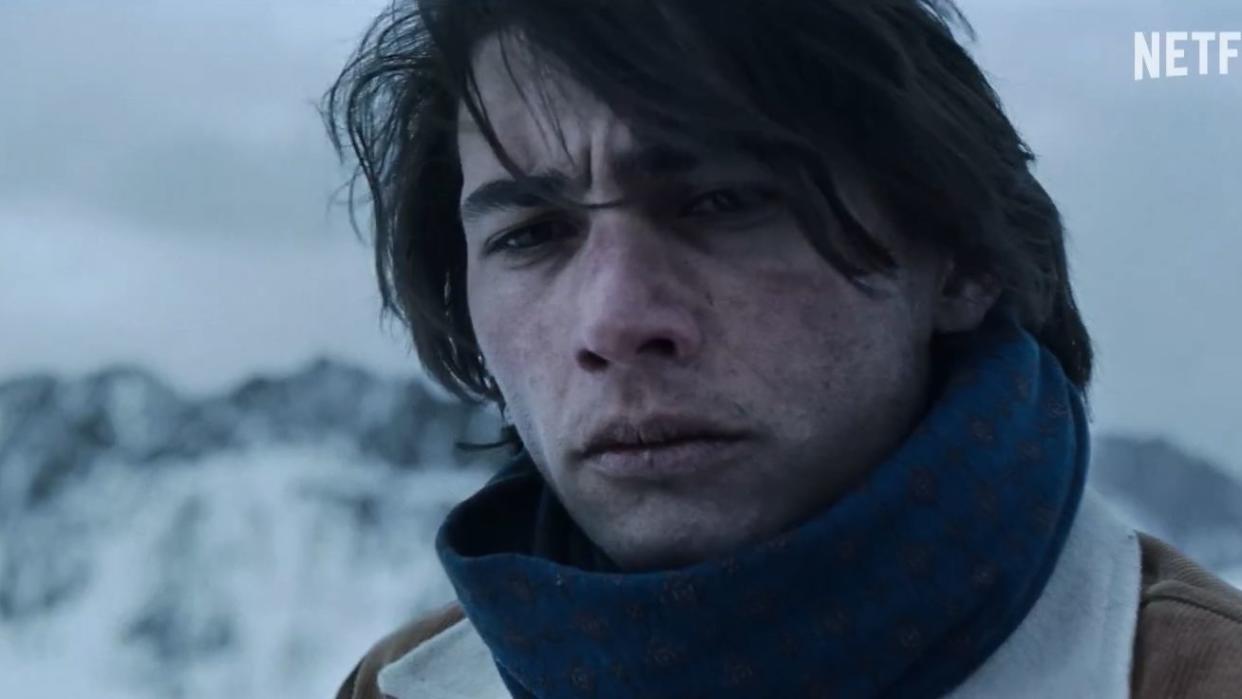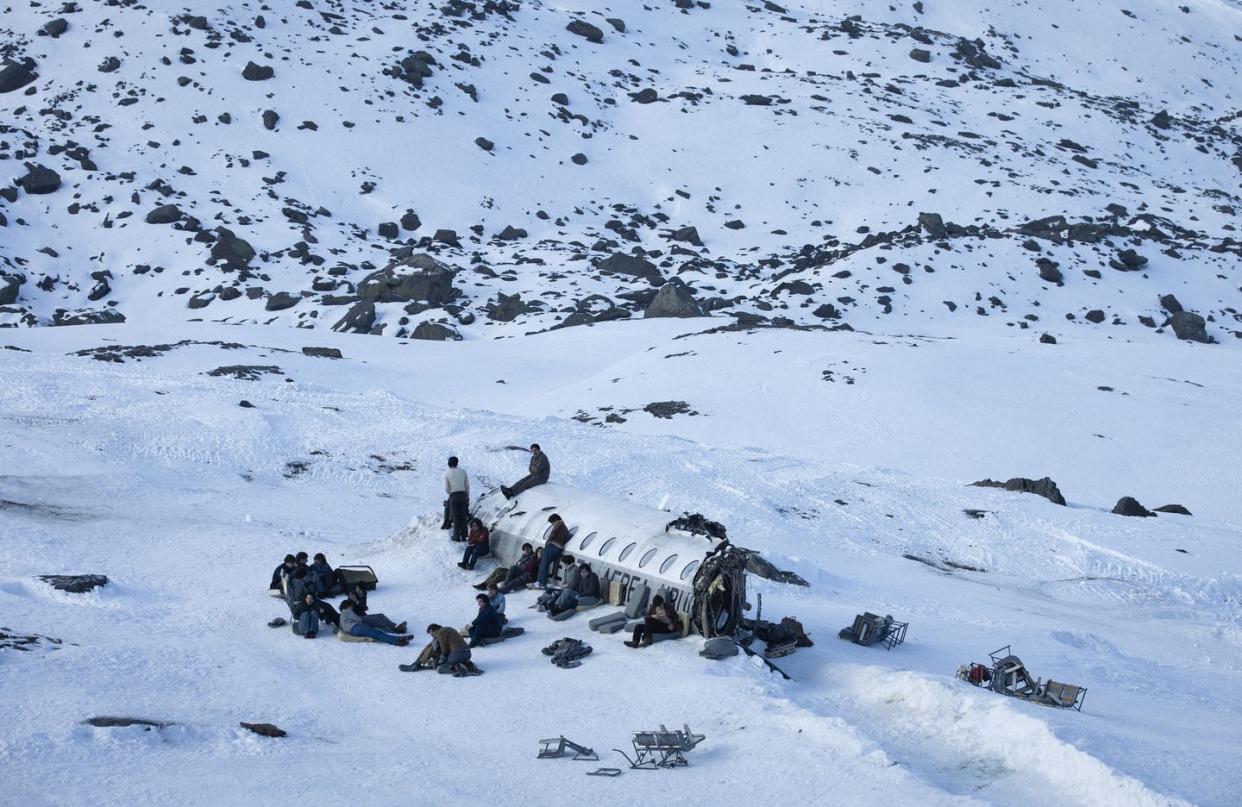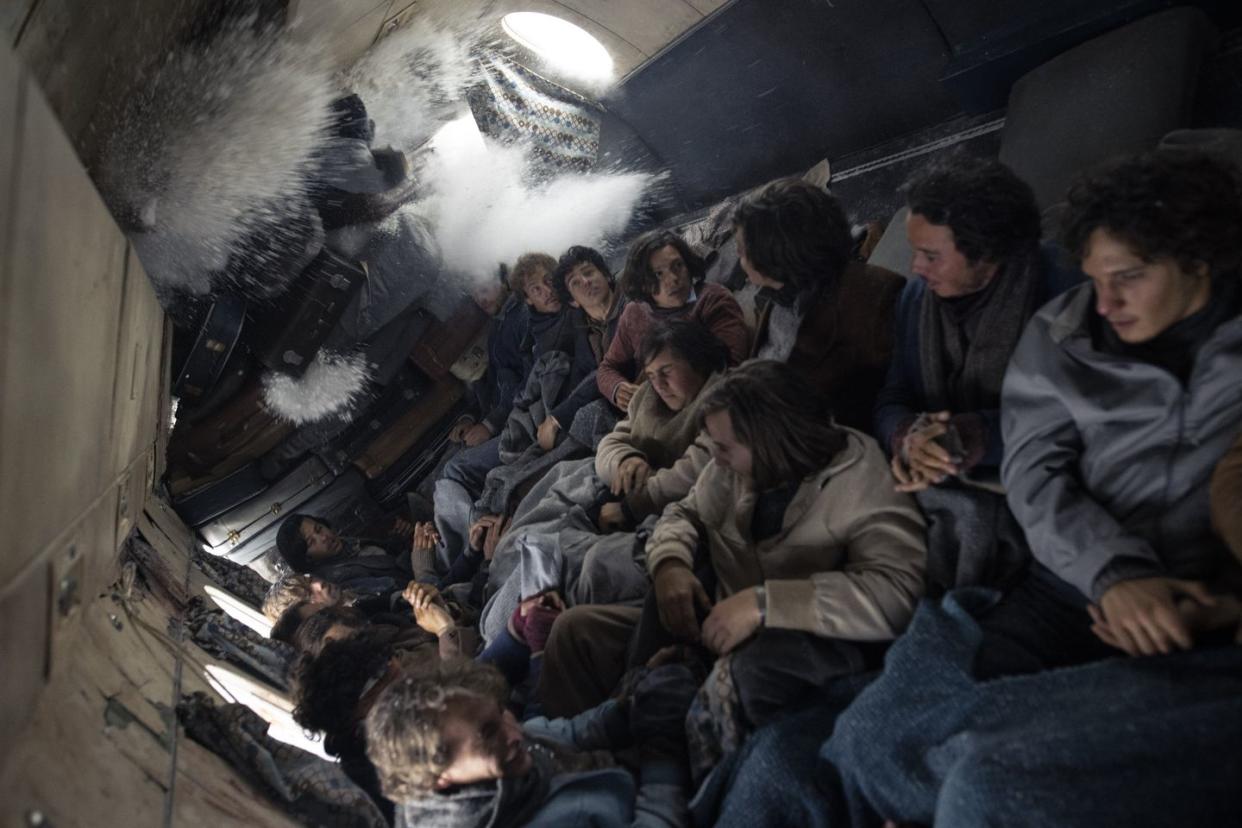'Society of the Snow' is Based on a Harrowing True Story

Netflix’s new film, Society of the Snow, is based on—like about half of Netflix's cinematic offerings nowadays—a true story. The movie is inspired by Flight 571, a plane that crashed in 1972, leaving a Uruguayan rugby team stranded in the Andes Mountains. Without food or water available, they resorted to cannibalism for survival. If this sounds familiar, you might remember a different adaptation of the story: 1993's Alive, which starred Ethan Hawke. Now, the harrowing tale has been recreated with Spanish-speaking actors. Among the cast is Carlitos Páez, who plays his father, Carlos Páez Vilaró, in the film.
Society of the Snow, which is directed by J. A. Bayona (The Impossible), is based on Pablo Vierci’s book of the same name. The film adaptation premiered in Spain on December 15. A week later, the movie was distributed to America, landing in theaters on December 22. Now, Society of the Snow is finally available to stream on Netflix. Since its release, the film has even generated some awards buzz, earning a nomination for Best Foreign Language Film at the Golden Globes.
If you want to learn more about the true story behind Society of the Snow, keep reading foreverything we know about the crash and what happened to the rugby team.
Who Was on Flight 571?
Flight 571 had 45 people on board, aside from the pilot and crew. The bulk of the passengers were members of a Christian Club rugby team, who were traveling from Montevideo Uruguay to Santiago, Chile for a game. The remaining travelers included the player's family and friends, and one woman who was on her way to her daughter's wedding.
Why Did Flight 571 Crash?
A multitude of errors led to the crash. First, the plane was ill-equipped to make the journey, due to its altitude limit and weak engine. It didn’t help that they were flying through rough conditions, too. Upon reflection, one of the survivors, Nando Parrado, told The Guardian that he and his teammates shouldn’t have boarded the plane. “A Fairchild FH-227D, very underpowered engines, full of people, completely loaded, flying over the highest mountains in South America, in bad weather,” he said. “I mean, no way.”
The next problem was the route. Because of the weather, the pilot had to land early in Mendoza, Argentina. Their bad luck continued when they realized they couldn’t stay in the country. The aircraft was leased from the Uruguayan Air Force and couldn’t legally remain in Argentina for 24 hours. Despite heavy winds, the aircraft took off again. While charting a new route to Santiago, the pilot realized he couldn’t fly directly to the area without going over the Andes Mountains, which were too high to pass through safely. Instead, he chose to fly over the Planchon Pass, which was at a lower altitude. About an hour into the flight, the pilot thought he’d made it to Curicó, Chile and alerted flight controllers that he arrived at the destination. They didn’t realize he was wrong, approving his request to land. When the plane descended, it crashed directly into the Andes, splitting the aircraft apart.
The impact tore off the plane's tail and wings, leaving just the fuselage behind. Twelve people died from the impact, while others suffered life-threatening injuries.

What Happened After Flight 571 Crashed?
After the crash, the survivors turned the fuselage into a shelter, using suitcases, clothing, and seats to create a wall that prevented snow from entering the enclosure. For a while, they were able to survive with the snacks they found on board, which reportedly included chocolate, candy, nuts, crackers, and alcohol. They also bottled snow and let it melt into drinking water.
About a week later, when supplies ran out, the passengers tried consuming leather torn from ripped suitcases. They even ripped into the plane’s seats, hoping to find straw or edible materials. Nothing. Soon enough, they considered something unthinkable: cannibalism. After holding a group discussion, most of the survivors agreed it was their only option. A few initially declined, but they changed their minds when they overheard that the rescue mission had been canceled through the plane's radio. In an ABC News documentary, Parrado recalled making a deal with his teammates. “We shook our hands, and we say, ‘If I die, please use my body. So at least you can get out of here. And tell my family how much I love them.”
For a while, the group ate the flesh of dead passengers. Then, they faced yet another tragedy. On day 17, they were hit with an avalanche that buried the fuselage—with them inside of it. Eight people died immediately. After a few hours beneath the snow, Parrado broke through the cockpit and managed to let air into the fuselage.
Unfortunately, the avalanche resulted from an ongoing blizzard. To keep warm, the team had to remain in the fuselage, and—after three days—resort to cannibalism again. When the blizzard stopped, they finally dug themselves out. At that point, the group decided to search for help. They spent a few weeks training for their departure, and on day 61, three rugby players left the fuselage with ample clothing and three days' worth of food. The remaining survivors stayed behind.

How Did the Passengers of Flight 571 Survive?
Before the pilot died, he told the passengers that they were in the western part of the Andes, near Chile. The men who lookeed for help—which included Parrado, as well as his teammates Roberto Canessa, and Antonio Vizintín—thought they could scale the mountain and land in civilization. What they didn’t realize was that the pilot’s orientation was off. After days of hiking, they arrived, once again, in the middle of nowhere.
While speaking to The Guardian, Parrado reflected on a conversation he had with Canessa at the time. “I said, ‘Come on, Roberto, I cannot do it alone. Let's go.” Parrado recalled. “If we go back, what for? I'm going to die looking into your eyes and who dies first?” Canessa agreed. Vizintín made a makeshift sled and found his way back to the fuselage.
Parrado and Canessa hiked for 10 days. Along the way, they spotted a campsite and walked toward it, eventually spotting a man named Sergio Catalan on the opposite side of a river. Parrado was able to get the attention of Catalan, who said he’d come back the next day. When Catalan returned, he brought his two sons and threw a note across the river with paper and a pencil attached to it. Parrado and Canessa wrote back and explained their situation.

According to ABC, the note said: “I come from a plane that crashed in the mountains. I am Uruguayan. We have been walking for 10 days. I have 14 friends wounded on the crash site. We need help. We don’t have any food. Please come and get us.”
After Catalan read the message, he traveled for 10 hours to alert the Chilean Army. Soon after, the military arrived and saved Parrado and Canessa. Meanwhile, a rescue team flew to the fuselage to retrieve the remaining survivors. Due to the treacherous terrain, they had to take two trips. The military rescued the first batch of people that day, and flew out the group the next morning.
The passengers survived for 72 days in the wilderness. When they finally arrived at a hospital, they were treated for altitude sickness, dehydration, frostbite, broken bones, malnutrition, and scurvy.
What Happened After the Passengers from Flight 571 Were Rescued?
Shortly after they were rescued from the mountains, the rugby players' story took over the news. Obviously, many people were disturbed by their cannibalism, but Canessa didn't mind. “Some thought it was good, some thought it was bad, but I couldn’t care less,” he told ABC. “They don’t have any kind of right to judge us.”
Years later, Parrado, Canessa, and their teammates—Eduardo Strauch and Carlos Páez Rodríguez—wrote books detailing their experience. Their accounts inspired films and television series over the next few decades, including the Showtime series, Yellowjackets. When the fanfare subsided, the rugby players were finally able to live in. Looking back, Parrado credits his teammates' relationship with each other for keeping them alive. “We trusted each other,” he said. “We fought for each other. So, this is a rugby story. Rugby saved my life.”
You Might Also Like
